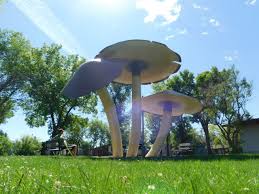 The outline of the giant fungus, strikingly similar to amushroom, stretches 3.5 miles across, and extends an average ofthree feet into the ground. It covers an area as big as 1,665football fields. No one has estimated its weight.
The outline of the giant fungus, strikingly similar to amushroom, stretches 3.5 miles across, and extends an average ofthree feet into the ground. It covers an area as big as 1,665football fields. No one has estimated its weight.

“There hasn’t been anything measured with any scientifictechnique that has shown any plant or animal to be larger thanthis,” said Gregory Filip, associate professor of integratedforest protection at Oregon State University and an expert inArmillaria.
Dead Trees Reveal Fungus
Until now, the largest known organism was another Armillariaostoyae found in 1992 in Washington State. It covered 1,500 acresnear Mount Adams.
“We just decided to go out looking for one bigger than the lastclaim,” Filip said.
Forest Service scientists are interested in learning to controlArmillaria because it kills trees, Filip said, but they alsorealize the fungus has served a purpose in nature for millions ofyears.
The discovery came after Catherine Parks, a scientist at thePacific Northwest Research Station in La Grande, Ore., in 1998heard about a big tree die-off from root rot in the forest east ofPrairie City, Ore.
Using aerial photos, Parks staked out an area of dying trees andcollected root samples from 112.
She identified the fungus through DNA testing. Then, bycomparing cultures of the fungus grown from the 112 samples, shedetermined that 61 were from the same organism, meaning a singlefungus had grown bigger than anything anyone had ever describedbefore.
Dry Climate May Encourage Growth
On the surface, the only evidence of the fungus are clumps ofgolden mushrooms that pop up in the fall with the rain.
“They are edible, but they don’t taste the best,” saidDreisbach. “I would put lots of butter and garlic on them.”
Digging into the roots of an affected tree, something that lookslike white latex paint can be seen. These are mats of mycelium,which draw water and carbohydrates from the tree to feed the fungusand interfere with the tree’s absorption of water and nutrients.
The black shoestring filaments called rhizomorphs stretch asmuch as 10 feet into the soil, invading tree roots through acombination of pressure and enzyme action.
The huge size of the fungus may be related to the dry climate ineastern Oregon, Dreisbach said Friday. Spores have a hard timeestablishing new organisms, making room for the old-timers to spread.

You must be logged in to post a comment.